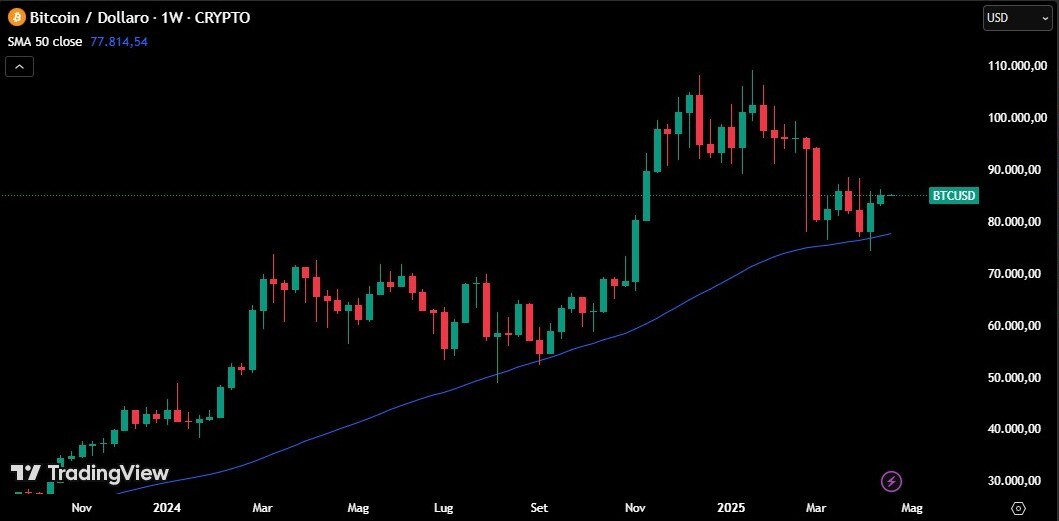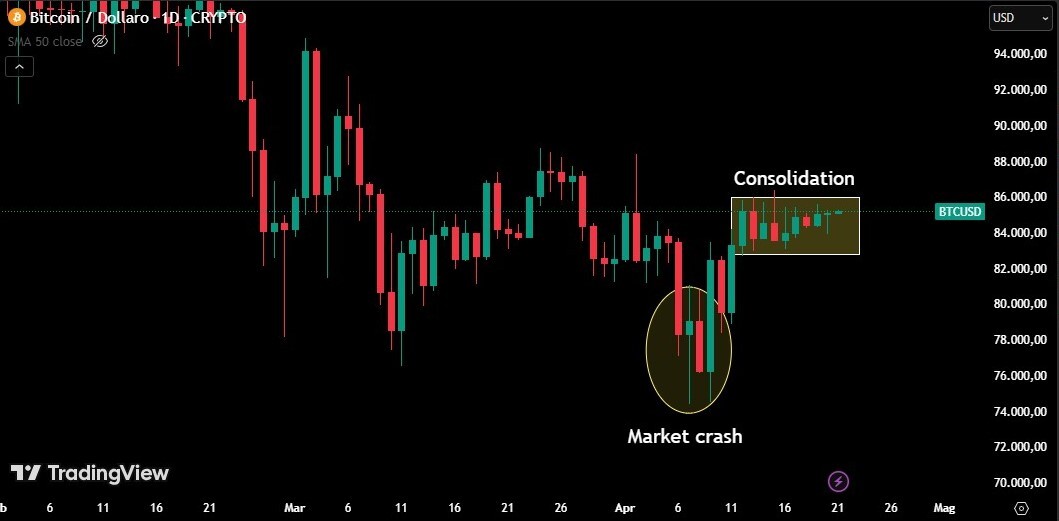Is Bitcoin Becoming a Treasury Reserve Asset?

We are at a turning point for Bitcoin. The year 2025 has been defined by a balance between the institutional adoption promised by the Trump administration and the recessionary macroeconomic headwinds the administration has generated through tariffs and the trade war.

Until a few days ago, the world's most famous cryptocurrency traded in a narrow range between $83,000 and $85,000, reflecting a phase of technical consolidation. For the first time, during a period of particularly severe turbulence and volatility in traditional markets, Bitcoin did not lose value—assuming the role of a safe haven that many early adopters had long envisioned.
But what factors prevented the Bitcoin price from collapsing at a time when virtually all market participants were fleeing risk assets? Let's examine the situation in greater detail.
After reaching an all-time high of $106,140 in December 2024, BTC underwent a corrective phase in Q1 2025.
To date, it has broken the $90,000 resistance level, and a return toward its peak is possible after a prolonged consolidation, even though its range-bound behavior has suggested traders were waiting for clearer macroeconomic signals (which never arrived) before taking directional bets.

One factor may be gold's own rally: as capital fled from the riskiest assets, those looking to diversify among safe havens may have turned to BTC, the only asset besides the yellow metal that has so far withstood the bearish forces.
Bitcoin's utility as an inflation or recession hedge remains controversial among analysts. U.S. annual inflation has eased to 3.2% from 5.4% in 2024, but recession risks persist. In the context of monetary tightening (with the Fed currently refusing Trump's calls for rate cuts), historical data suggests that a new sustained bull run is unlikely under these conditions.
However, the cryptocurrency's correlation with risky equities has weakened to 0.35 from 0.75, suggesting a decoupling from traditional markets. Whether the trade war, dollar weakness, and economic uncertainty have changed Bitcoin's paradigm — potentially elevating it to a long-term safe haven — remains to be seen.
Thirty-eight percent of institutional investors surveyed by JPMorgan now consider Bitcoin a "legitimate Treasury reserve asset," up from 12% in 2024.
A crucial element in reducing Bitcoin's volatility and supporting its price has been MicroStrategy. Michael Saylor's company has become a cornerstone of Bitcoin's institutional narrative. Its strategy is to issue debt to finance Bitcoin purchases so that MicroStrategy shareholders gain "leveraged" exposure — potentially earning more than by buying BTC directly (while also taking on greater risk).
During recent market turbulence, MicroStrategy sold its own shares to continue buying BTC, playing a vital role in keeping the cryptocurrency's price within acceptable bounds. Today, the company appears to hold about 214,400 BTC (roughly $18.3 billion at $85,000/BTC), making it the second largest institutional holder after BlackRock's ETF. Saylor has repeatedly affirmed a "no-sell" policy, providing essential psychological support.
Bloomberg analyst Eric Balchunas notes that MicroStrategy's continuous BTC purchases have "reduced Bitcoin's volatility by 22% compared to pre-ETF levels."
Bitcoin ETFs shifted from net inflows to net outflows in Q2 2025, reflecting a change in investors' risk appetite toward safer investments. In Q2, they saw net outflows of $749.9 million versus inflows of $4.2 billion in Q1 2025.
Despite recent outflows, Bitcoin ETFs now represent 12% of the circulating supply, up from 3% in 2024, underscoring their success. This institutionalization provides structural support, as ETF investors typically have an annual turnover of around 15%, versus 300% for exchange-based traders. Analysts predict that ETF-driven demand could absorb 95% of new Bitcoin supply after the 2028 halving, radically altering market dynamics.
Bitcoin's trajectory in 2025 depends on the resolution of U.S. macroeconomic tensions—namely, whether U.S.-China tariffs will be eased. Traditional markets are awaiting concrete signs of an impending U.S. recession; any signal that brings this scenario closer will be critical for the pricing of risk assets and, by extension, Bitcoin.
Investors should continue monitoring ETF flows—the primary drivers of institutional demand and price stability—and watch whether MicroStrategy can sustain its debt-financed BTC accumulation strategy, even selling shares during crises, and uphold its no-sell commitment. A major BTC sale by MicroStrategy could severely undermine confidence and trigger a true bear market for Bitcoin.
About The Author
Contact Dylan Bailey privately here. Or send an email with ATTN: Dylan Bailey as the subject to contact@investorshangout.com.
About Investors Hangout
Investors Hangout is a leading online stock forum for financial discussion and learning, offering a wide range of free tools and resources. It draws in traders of all levels, who exchange market knowledge, investigate trading tactics, and keep an eye on industry developments in real time. Featuring financial articles, stock message boards, quotes, charts, company profiles, and live news updates. Through cooperative learning and a wealth of informational resources, it helps users from novices creating their first portfolios to experts honing their techniques. Join Investors Hangout today: https://investorshangout.com/

